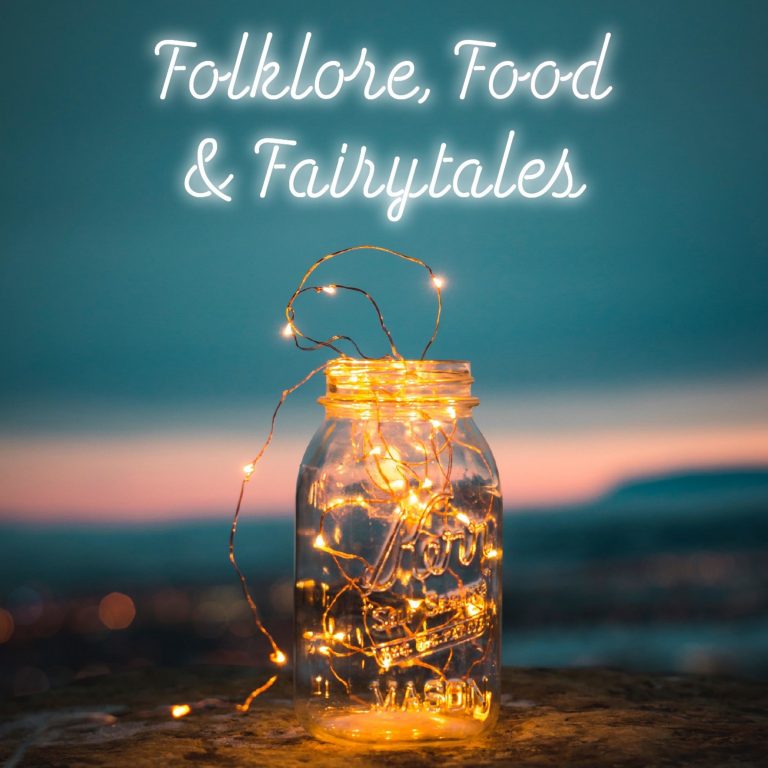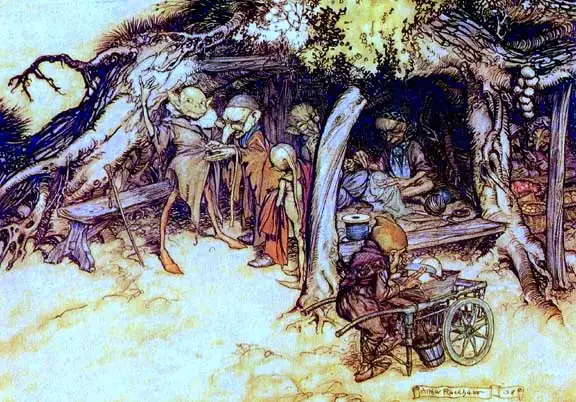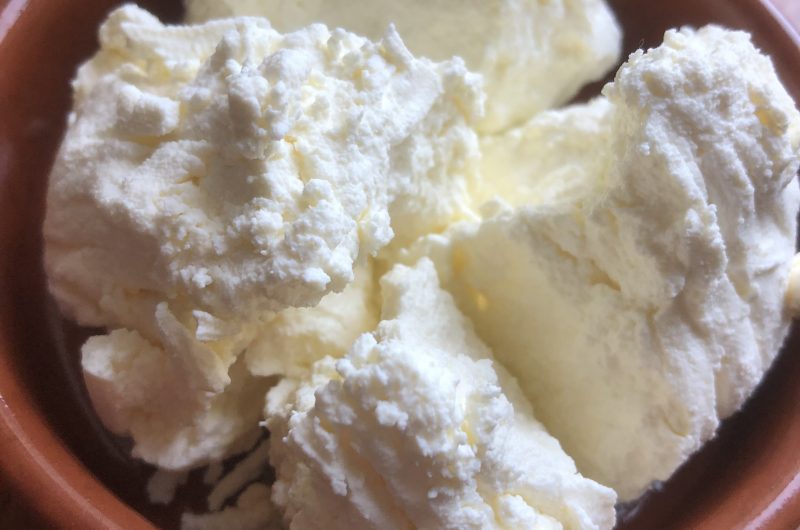In which we find out that certain tropes aren’t always true, that a heart of gold sometimes needs assistance and that brownies and a bannock in the house are invaluable. We also venture into peat bogs and cheese riots in pursuit of food and folklore.
In which we find out that certain tropes aren't always true, that a heart of gold sometimes needs assistance and that brownies and a bannock in the house are invaluable. We also venture into peat bogs and cheese riots in pursuit of food and folklore.
Our story: The Laird with a Heart of Gold adapted from Thistle and Thyme : tales and legends from Scotland – Sorche Nic Leodhas
Our Recipe: Fresh Cheese
If you would like to hear more about what I talked about in this episode you can find books and links at Further Reading
You can find more about me and the podcast via my Linktree
You can find the interviews in my newest interview series here: How Food Frames Stories. You can find my interviews with storytellers here: Vernacular Voices of the Storyteller
You can also subscribe here (or just read) my free newsletter for further snippets of folklore, history, stories, vintage recipes, herblore & the
occasional cocktail.
You can also find out more at Hestia's Kitchen which has all past episodes and the connected recipes on the blog. If you'd like to get in touch about the podcast you can find me here

What did you think of the tale? It is a little different to our normal tale but the book from which this tale is adapted suggests this was based on member of the Grant Clan so it is not a traditional tale but it is a newer folk tale which uses very traditional folklore elements but seems to be set in in the 18/19 century. The original storyteller places it slightly north of Inverness. I found it fascinating to see the impact on traditional folkloric creatures like brownies as education became more prevalent, people started to disbelieve in them and no longer wanted them in their homes.
Some Background in Reality
It was also interesting that the hero of the tale was a landlord not a person who starts out as a victim of a grasping landlord. I did also feel a little bit for the tenants, after years of being taken advantage of, it must have seemed almost irresistible to seize the opportunity to have the upper hand, especially when you consider how hard it could be subsistence farming in the North of Scotland. As we don’t know the date of the origin of this tale, we don’t know if it coincided with the tragedy of the Highland Clearances. Many forced evictions took place in former clan lands, sometimes because landlords were in a financially precarious position themselves.
A Clueless Hero
It could be thought that the brownies were trying to enforce the old world order but I like to think they are just helping someone who was at a disadvantage because he was essentially kind and well-meaning and had taken them in and shared what little he had. Helping the kind but slightly clueless hero is definitely a traditional role for one of the friendlier fair folk. You’ll have to let me know your opinions.
A Background in Brownies
I have made a big assumption here that you know all about brownies and their connection with food in tales, so maybe I should just give a brief overview for those of you who are thinking ‘what exactly are brownies?’ as this tale doesn’t give much away about their back story. Brownies or Pucas are the type of fairies that bring good fortune to your home and family and either do household chores on your behalf or improve the skill of the person doing the chores so that the house always looks very clean and well kept and bread always rises, food never spoils, crops are always good and animals thrive. Any business enterprises outside the home are also blessed with success.
Say Thank You With Food
These brownies are thanked by gifts of food which are never brought to their attention, just left in a certain place as an explicit offer of reward would make the brownie leave. These gifts were often cream, a slice of good bread or cake, sometimes spread with honey. According to William Henderson in Folk-Lore of the Northern Counties, children were sometimes told when they had a particularly nice treat: “There’s a piece wad please a Brownie.” Taking away a brownie’s food could cause it to become spiteful and mischievous, causing food to spoil, crops to fail, animals to fall ill and increasing bad luck and damaging property. These turned brownies were known as boggarts.
The brownies in this story are unusual because they make their presence known. Usually, they are quite secretive creatures and only the results are their handiwork are ever seen, not the creatures themselves. The only other story I know is an English tale known as Food, Fire and Company which I have told on this podcast as part of a collection of cosy stories for the cold, dark parts of the year.
No Brawn Today
So its probably time to move to our food selection from the story, we could have had brawn but I literally didn’t fancy it, although I must admit I haven’t tried it. I’m probably being hypocritical, if it was presented to me as a delicious terrine I’d probably dive in before you could say toast. Anyway I imagine that it wouldn’t be a good topic for everyone, or most people actually. So, we’ll concentrate on the slightly more appealing Scottish cheese and bannocks. They have a rich history and an interesting place in folklore and thankfully no pigs will have to be sacrificed in the interest of this podcast.
Those Typical Romans
I have specified Scottish cheese because it has a different history to English cheese for various reasons that incorporate geography, lack of cows and the Roman lack of ambition/inability to conquer the Scots (pick your preferred version) that had them stopping at Hadrian’s wall. This had a significant impact on they types of cheese made because a lot of the techniques used in England for making hard cheeses came from the Romans, so early cheeses in Scotland were of the acidic soft type like crowdie (a soft fresh cheese made with skimmed milk) and Caboc (soft fresh cheese made from cream, rolled in oats). Additionally these could be made from sheep and goat’s milk if cow’s milk was in short supply.
Ayrshire Cows
The majority of hard cheese which was made outside of Ayrshire was very hard and dry as it was made from skimmed milk with the cream skimmed off for butter making. Ayrshire had more cows and fertile grazing land and it is where Dunlop was invented in the 1700s. Dunlop is more of a young cheddar type cheese but in the highlands where our laird is from (just outside Inverness) he and his servants would very likely have been eating that very hard skimmed milk cheese or crowdie as Caboc was a cheese for the wealthy due to being made with cream. Maybe the Laird could afford it when his fortunes changed.
Crowdie and Caboc
Crowdie is a very old cheese, made by most families that had a cow, it was made by taking raw skimmed milk and leaving it for 24 hours to sour. As it soured the curds naturally separated leaving behind the whey. The curds were then pressed and drained to make a soft, spreadable cheese. You can still make it now but using pasteurised milk and heating and adding vinegar/lemon to act a souring agent.
Caboc on the other hand has a complete different origin story, almost a folk tale in its own right or perhaps a legend. The story starts in the fifteenth century with Mariota de Ile, the daughter of the chieftain MacDonald of the Isles. It was thought that from the age of 12 she was in danger of being kidnapped by the Campbell clan and forcibly married to one of their own so they could steal her estates. In order to remove her from danger, she was smuggled to Ireland for her safety. It was there that she learned the secret of full cream cheese making and the recipe was developed.
The recipe was said to pass through an unbroken female line from mother to daughter all the way from Mariota to the current cheesemaker, Susannah Stone in Tain, Scotland. Susannah reinstated the making of this cheese in 1961 using the still secret recipe. It is also said that rolling the cheese in oats began when a long-ago herder stored his cheese in a box previously used for oatcakes and liked the taste so much that Caboc was then always made that way. Another less romantic version is that Susannah added the oats herself to improve the taste and texture.
Cheese Riot
Don’t think the hard Sottish cheese is without any folklore of its own. Inverness actually had its own cheese riot in 1666 close to the castle, after a man dropped a piece of cheese into the river and refused to pay for the damages. This argument turned into a full-scale riot. The town guard was summoned, muskets were raised and shots were fired. Two people were killed and ten people were injured. This was not the only outcome, tragedy as it was. It turned out the two killed belonged to the MacDonald clan (the self same clan whose daughter first made Caboc) and they wanted compensation of £66,000, tax exemption, any Invernessian to submit to a MacDonald, amongst many other demands. In the end Inverness only had to pay £4,800. The saddest thing is my mind is that no-one seems to be able ascertain whether the original cheese monger was paid for their cheese.
Tyromancy for the Win
One more piece of Scottish cheese folklore, the was once a cheese used for divining the future known as Laomachan or ‘Little mouldy one’, The cheese had to made on one of the four old festivals of the Gaelic year: Beltane; Lughnasa, Imbolc or Samhain from the milk of cows that have grazed on Mothan or Bog Violet. The milk of these violet chomping cows was also said to protect the drinker from any future supernatural mischief no matter the time of year. If a child drank the milk they would be protected from fairy abduction in particular.
Bannocks for Nothing
So finally, we turn to the famous Scottish bannock which is defined by the Oxford English Dictionary as ‘the name, in Scotland and north of England, of a form in which home-made bread is made; usually unleavened, of large size, round or oval form, and flattish, without being as thin as ‘scon’ or oat-cake. In Scotland, bannocks are usually of barley- or pease-meal, but may be of wheaten flour’. The word comes from the Gaelic bannach which means either morsel or little cake depending on where you look. The Old-English version of the word is bannuc and it is suggested that these all come from the root latin word panicium meaning anything baked.
There is written evidence of the old English version in 1000CE so it suggests this is a very old bread. The Scottish version was baked on a bannock stone over the fire and then portioned into slices like a cake. You can still get this, often served with thick seafood soups like Cullen skink. It often uses oatmeal and sometimes baking soda to give it a lift but its still as substantial filling bread today.
A Mother’s Blessing
It appears in many a folk tale with mothers’s asking their youngest sons if they will take the whole bannock with her curse or half with her blessing. There’s more to that as I think I’ve mentioned before as by leaving, the youngest son is removing the main source of only very few sources of income available to his mother. If he takes the whole bannock he is leaving her with nothing. By only taking half, he is recognising that she will need some form of sustenance and that he isn’t only thinking of himself.
The first bannock in a tale I always think of is the one which contains an iron bar given to Cuchulain by Oonagh in The Legend of Knockmany which breaks the giant’s teeth. It was one of my favourite tales as a child and I even made an episode of it in 2020 should you fancy a listen. I talk about soda bread in that episode but it was much more likely to have been this type of unleavened bread. There are also links to recipes for bannock type bread in the Further Reading for that episode.
Druidic Sacrifice
There is also a possible link to bannocks being used as a way of choosing a sacrificial victim in druidic sacrifice. I must admit that I don’t know much about current druidic practice so if you are interested in that, there are some good books including a taster in the Book of English Magic by Philip Carr-Gomm & Richard Heygate but I’m certain any sacrifices that are conducted now are not of the human kind. However there is some evidence to suggest that in pre Roman Britain and other Northern European communities human sacrifice did take place. It is believed that one of the ways to choose the sacrifice was via a burned piece of bannock. The person who received the burned piece would become the sacrifice.
Lindow Man (or Lindow II) is the connection between druidic sacrifice and bannocks. He is a body that was found in the Lindow Moss peat bog near the town of Wilmslow and his death is placed roughly between 2 BCE and 119 CE. The story of how he and an earlier skull from a similar period were found, and how they were complicated by a much more modern twentieth century murder mystery is fascinating. You can find a link in further reading at the bottom of this page should you wish to know more.
Mistletoe & Bannock
Anyway, back to our bannock and druidic ritual link: Lindow man’s stomach contents were analysed and were found to contain emmer, spelt wheats and barley which were probably ingested in the form of unleavened bread; Spagnum leaves and also Viscum album known more commonly as mistletoe. There is evidence to suggest some of the grains in Lindow Man’s stomach were burned and the presence of mistletoe, a hallucinogenic, often used in early Druidic rituals, does suggest the possibility of druidic ritual especially as where he was found would have been at the edge of the water, a liminal space for sacrifice.
Although there is no definite evidence that this is actually what happened to Lindow man as different archeologists have different theories and it is difficult to prove one over the other. One of the other theories suggests a contemporary murder or robbery-murder due to the nature of the body’s injuries. I’ll leave you to investigate further should you wish to and come to your own conclusions, furth information is below.
A Recipe for Love
My final task is to leave you with a recipe. I though in this case, a soft homemade cheese would be ideal. I have flavoured this with salt but you could fresh herbs or spices for flavouring. It isnt that far off crowdie although we make it now with full cream milk.
Fresh Cheese
5
minutes2
hoursA home made soft cheese without rennet
Ingredients
4 pints of full fat milk
juice of about 1 lemon or 1-2 tblsps of white vinegar
Double cream
Flaky salt
Directions
- Add the milk to the pan and warm gently.
- Heat the milk to around 85-90 degrees C. You don’t want to heat the milk up too hot as it will toughen the curds.
- Remove the from the heat and add the lemon juice/vinegar
- The milk will slowly start to separate into curds and whey. If it doesn’t start after a minute, add more lemon or vinegar 1 tsp at a time. The fresher the milk, the more acid you may need
- Once the separation is complete pour the liquid through a muslin lined sieve over a bowl, add a few flakes of sea salt and bring the top of the muslin over the cheese to cover. You can tip the whey away or use it for baking
- Leave to drain fully for around 2-3hrs
- At this stage you can remove the cheese ball from the muslin and place in a bowl or plate or you can add a weight on top of the muslin wrapped cheese and leave for another hour for a firmer, crumblier cheese
Notes
- If you don’t use straight away this needs to be refrigerated for up to 3 days
- The recipe photo uses the unpressed version of the cheese
Further Reading
Thistle and thyme : tales and legends from Scotland – Sorche Nic Leodhas
https://cullodenbattlefield.wordpress.com/2020/12/02/a-violent-history-of-inverness-castle/
https://www.thecourtyarddairy.co.uk/blog/cheese-musings-and-tips/scottish-cheese-the-great-revival/
https://www.teddingtoncheese.co.uk/acatalog/de367.htm
http://www.dunlopdairy.co.uk/cheese.html
https://etheses.bham.ac.uk/id/eprint/10131/7/ZeinElabdin2020PhD.pdf
https://sciencehistory.org/stories/magazine/bodies-in-the-bog-the-lindow-mysteries/


